Designing a Landscape Lighting System
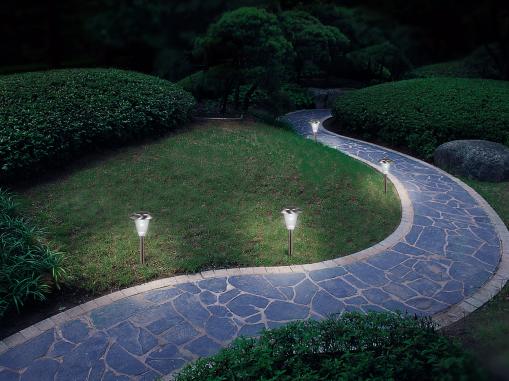
Installing an exterior landscape lighting system is a great way to add beauty, curb appeal and safety to your home garden, walkway and entrance areas. Plus, if you have an existing system, it can easily be enhanced or adapted to reflect new layouts, styles, or landscaping updates. In this article, you’ll learn the basics of how to design your landscape lighting.
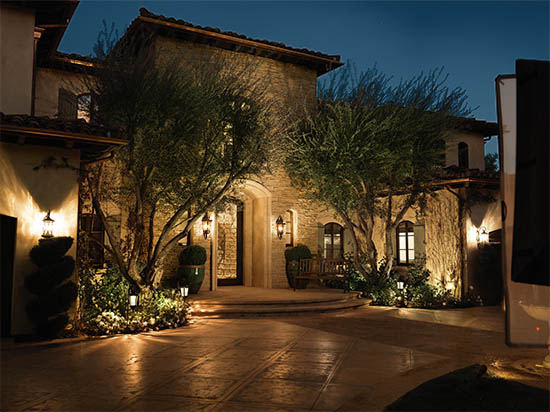
Getting Started with Landscape Lighting
Before you start purchasing items, it’s best to get a few things in order to avoid extra headaches, trips to the store, or worse—incompatible components. We recommend first grabbing a notepad and pencil and doing a walkthrough of your property to get a sense of how you envision your system.
General ideas to keep in mind as you plan
- Decide what exterior areas or objects you want to light.
- Select the appropriate lighting techniques.
- Choose the fixtures and accessories that give you the desired effect.
- Choose the power supply, either line or (more commonly) low voltage.
- Select the appropriate bulbs.
Landscape Lighting Techniques
Accent or Spot Lighting
Landscape spotlights focus a controlled intense beam to highlight the focal points in your garden: flowers, small shrubs, and statuary. This creates sparkling islands of interest in your landscape lighting plan.
Grazing
Positioning the light close to an interesting surface can bring out the texture of tree bark, a masonry wall, wood shingles or an attractive door. Grazing of smooth surfaces is not usually recommended.
Shadowing
Light the object from the front and below to project intriguing shadows on the wall or other vertical surfaces.
Silhouetting
When you conceal lights behind and below a tress or bush, you achieve that same wondrous effect as seeing it on a ridge silhouetted against the sky at dusk.
Pool and Fountain Lighting
Underwater lighting creates dramatic effects in pools and at fountains. Install a dimmer for turning lights up to add excitement. Note: Water may be used as a mirror by lighting the area behind the reflecting surface.
Downlighting or Area Lighting
Mount lighting units high up in trees or on the house to cast broad illumination over wide areas. Landscape flood lighting enables you to entertain in your backyard or outdoor area after dark, and does double duty for security and safety. For highlighting flower beds, paths or steps, the downlight is positioned close to the ground.
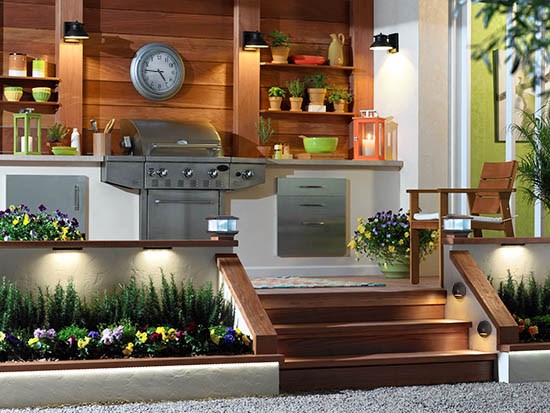
Cross Lighting
Illuminating a tree or statue from two or more sides reveals the three-dimensional form in a striking perspective.
Uplighting
Lights aimed upwards (sometimes buried in the ground) create a highly dramatic effect akin to the theater. Use a spot or flood light for lighting trees, illuminating a statue, or lighting a textured wall surfaces. Autumn leaves or swirling snow provide spectacular views. Focus the light on the key plants or objects in your yard.
Spread or Diffused Lighting
Where you require circular patterns of light on flower beds, larger shrubbery or ground cover, spread lights cover a wider area with low-level illumination. Some units, such as these bollards, cast softly diffused lighting for patios, decks, driveways and pathways. Wall brackets provide a similar lighting function. The path or flower bed should be more illuminated than the actual fixture.
Moonlighting
Like downlighting, but using soft light sources positioned very high up, this technique simulates the lovely effect of moonlight filtering through branches, casting attractive shadow patterns.
Landscape Lighting Areas
Close-By-House
Illuminating side and rear entries to the house, as well as walls with easy access widows, can discourage prowlers and thieves.
Driveway Lighting
Highlighting your driveway with light also improves safety and security, while the delineation creates an attractive pattern.
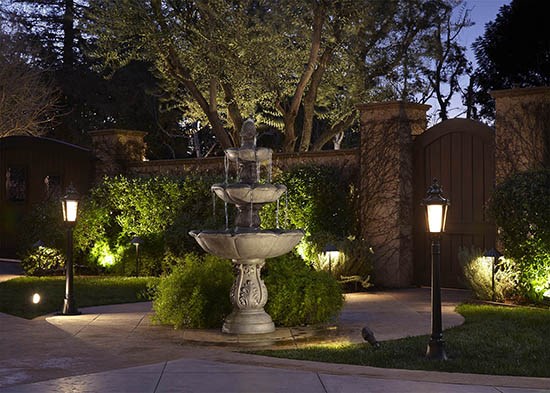
Rear Yard Lighting
Floodlighting from house or trees helps discourage intruders and vandals. Where you can’t conceal the light source, select units which look attractive—not industrial. Arrange for automatic timers, photocells or motion sensors.
Front Entry Lighting
Provide a warm welcome after dark. Select a wall bracket which casts adequate illumination on front steps, as well as lighting the keyhole and house numbers.

Steps and Paths
Frequently neglected, but also important to avoid accidents in dark locations, are low path lights, post lanterns and lights attached to the house.
Garage
Ample lighting over the garage will enhance both safety and security, particularly when other lights are not on.
Types of Landscape Lighting Fixtures
Cylinder, Box Shape and Bullet Shape
These designs help focus and direct the light beams. Some also cut off glare and protect the lamp and socket from debris and moisture.
Spread and Diffused
These low-level units are designed to cast illumination in a broader pattern for; flower beds, perimeter plantings, driveways, steps and paths.
In-ground or Well Light
Burying these fixtures flush with the ground conceals the light source. Use for uplighting trees and shrubs, and grazing textured walls.
Spot or Accent
Versatile/adjustable fixtures used for uplighting, crosslighting, accenting and grazing; when mounted high up provide focused downlighting and moonlighting.
Wall Bracket, Ceiling Close-up, Chain Lantern
Mounted at entry doors, over garages and on porches, these chain-hung lantern style units cast light outward—either direct or diffused.
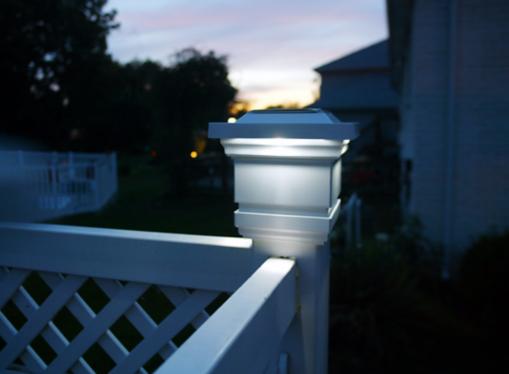
Bollard and Post Lights
These standing fixtures light pathways, steps, garden walks, deck and pool areas. They also provide attractive light patterns for driveways.
Swimming Pool and Fountain Lighting
These fixtures are installed in sides and at ends of swimming pools and bottoms of fountains. Wet niche fixtures can be removed for lamp changes, while dry niche fixtures require access to the back of the pool shell. Colored lighting is popular for this application.
Timers, Transformers and Other Accessories
Automatic timers, photocells, or motion sensors which turn lights on at dusk and off at dawn make landscape lighting convenient and energy saving. See manufacturers catalogs for other accessories which may be required.
Landscape Lighting Tips from the Pros
Jeff Emerson, lighting expert from the Lamps Plus Professionals trade pricing program, offers these tips to achieve a professional look.
- Conceal the landscape lighting source when possible—except where the fixture itself is a decorative element.
- Don’t overdo it! A little light goes a long way at night.
- Be creative in using a mixture of lighting techniques.
- Arrange for an automatic device like a timer to turn lights on and off.
- Be considerate of your neighbors. Aim lights so they do not shine into their windows.
Outdoor Light Bulbs
Finally, don’t overlook landscape light bulbs. The wide variety of available bulbs means that you can tailor your choice to your needs. You may prefer soft illumination in some areas, bright in others. Watts are a measure of electricity consumed, but some bulbs yield more light than others of equal wattage. Remember the longer the distance of light throw, or the greater the intensity desired, the more light output will be required.
It may seem obvious that bulbs which deliver more light and are more efficient generally cost more. Some cost considerably more, but you must also compare the rated lamp life, since some lamps costing several times more usually last several times longer.
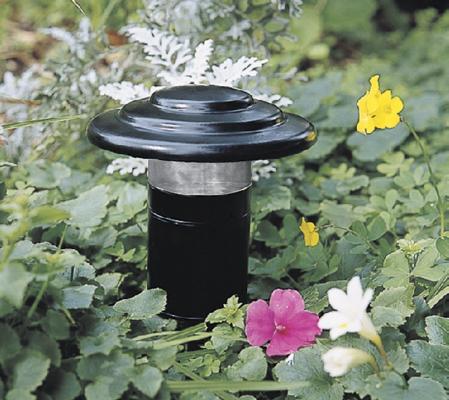
Efficiency, Energy Savings and LEDs
Some types are more efficient than others. Low voltage, for example, can save energy by concentrating light beams, but it generally lacks the equivalent beam throw of line voltage. Newer 65- and 120-watt incandescent bulbs yield up to 25% more light. New compact fluorescent bulbs provide soft lighting and the highest energy savings. Mercury vapor bulbs offer strong illumination with energy savings, but project a cool color suitable only for greenery.
Best of all are LED bulbs or lights with built-in LED arrays. LEDs are the future of landscape lighting are fast becoming the standard lamp of choice for the industry. They last for years, eliminating the need for time-consuming bulb changes, and they use very little energy, allowing you to place more lights on the same transformer, or use a smaller, less expensive transformer.
Quartz/Incandsecent Tungsten-Halogen
Compact light source which provides a consistently bright light. Also available as a reflector (MR) and as a projector (PAR) type. These fit into smaller and less obtrusive fixtures.
Fluorescent
White long tubes are primarily used for walls, banisters and signs, compact fluorescent bulbs provide a soft light quality and the highest energy saving. (Some temperature restrictions apply.)
Mercury Vapor/High Pressure Sodium
This family, known as high-intensity discharge, provide intense light at low energy cost. Their color renditions limit use, and they do not go on immediately—they must warm up. Note: Most of the above types are available for either 120-volt or 12-volt systems, but you must specify the system. Fluorescent, Mercury Vapor and High Pressure Sodium are for 120-volt only.
Incandescent A
Standard type commonly used around the home. Inexpensive, but yields less light than other incandescents.
Incandescent B
Reflector type, either flood or concentrated spotlight. About twice the light output of A bulbs.
Video Inspiration
Get more inspiration from the Lamps Plus YouTube channel, including a video on our new Super Duty collection of large and tall landscape lights (see video below).
Questions About Landscape Lighting?
Call 800-782-1967 to speak with one of our friendly, professional Lighting & Home Decor Consultants or visit a Lamps Plus location near you. Whether via phone or in person, we’re happy to assist you in completing your project.
More Landscape Lighting Ideas and Advice
Landscape Lighting – Tips for Getting Started
5 Things to Know Before You Buy Landscape Lighting
